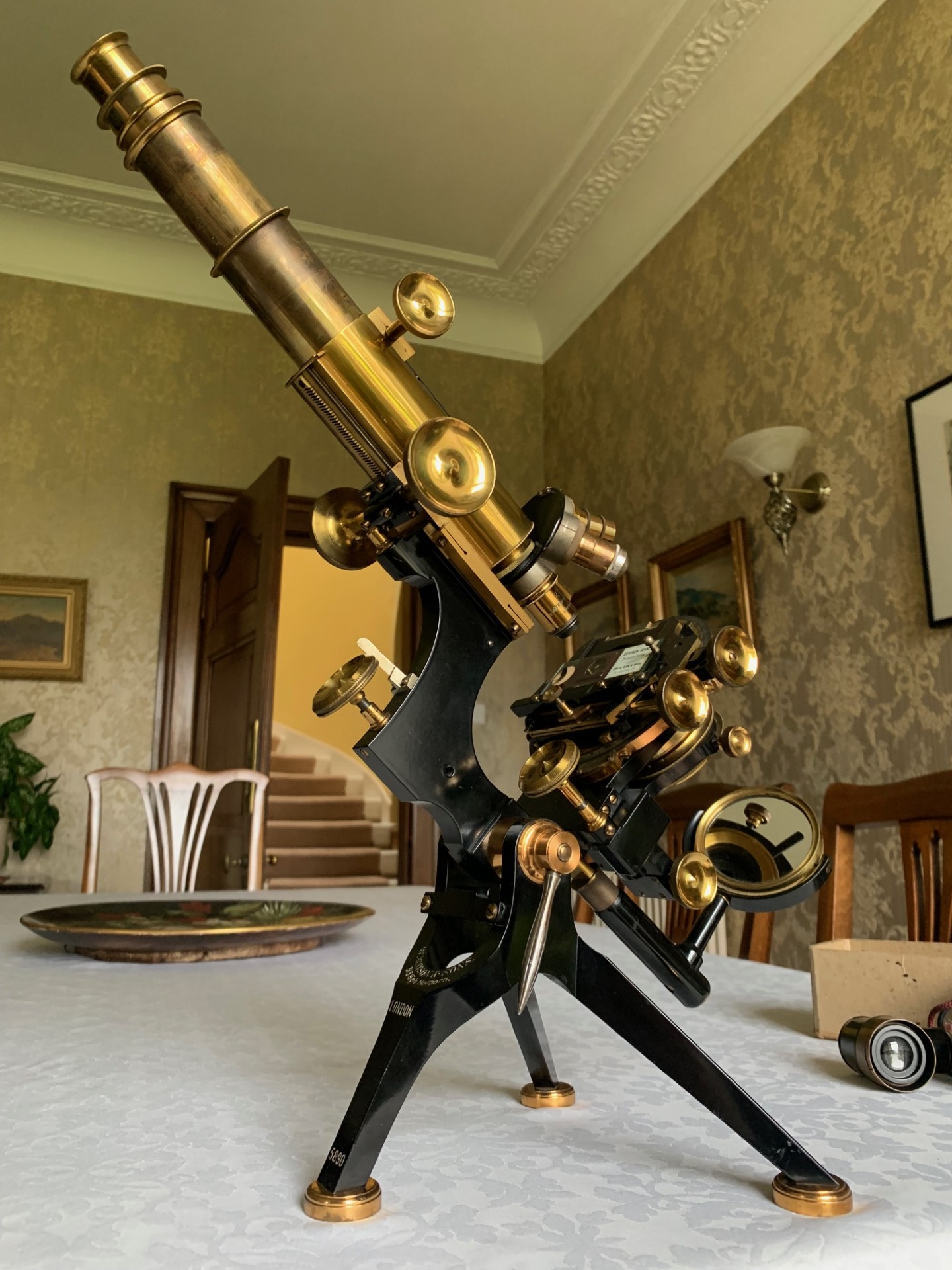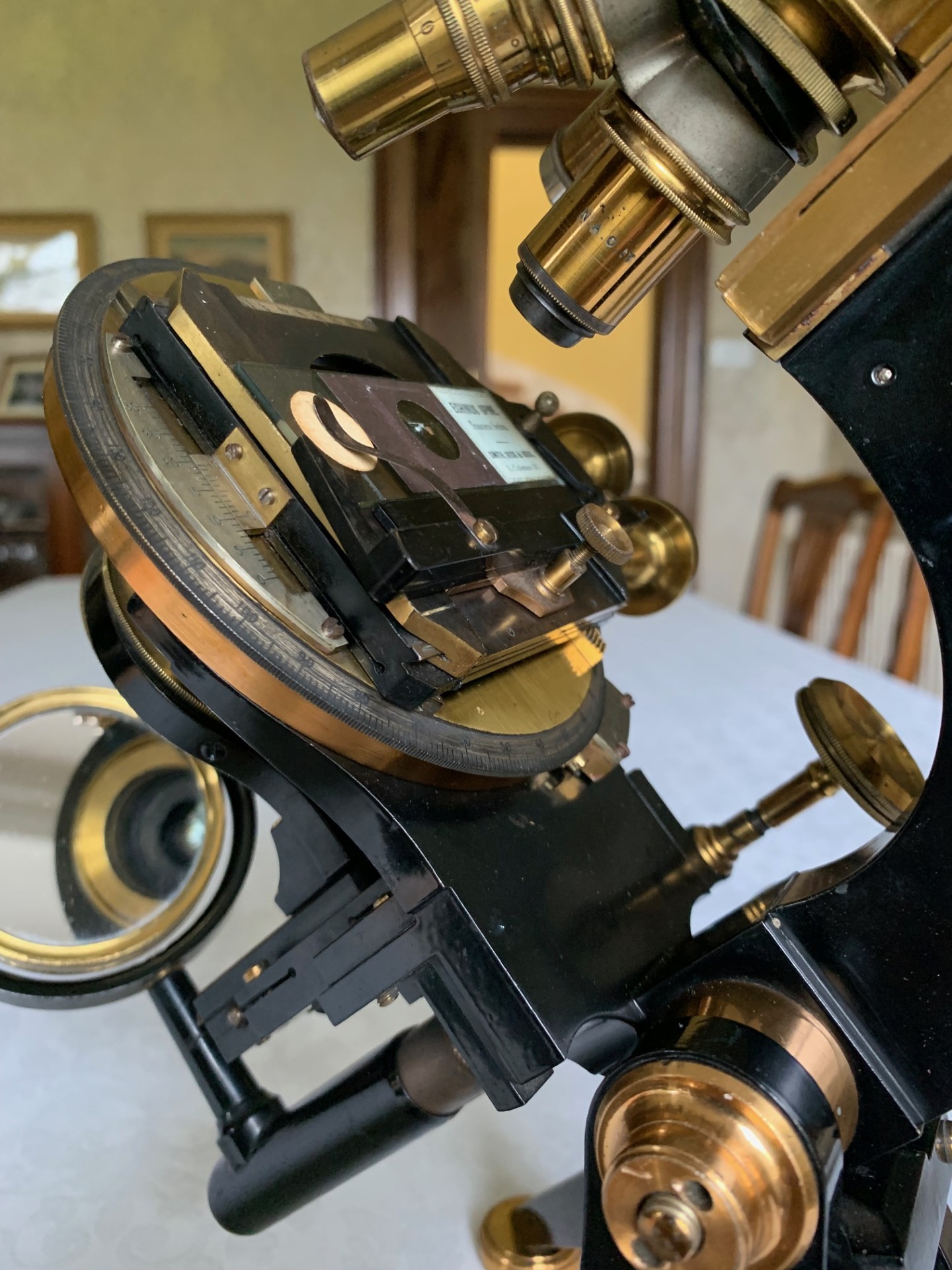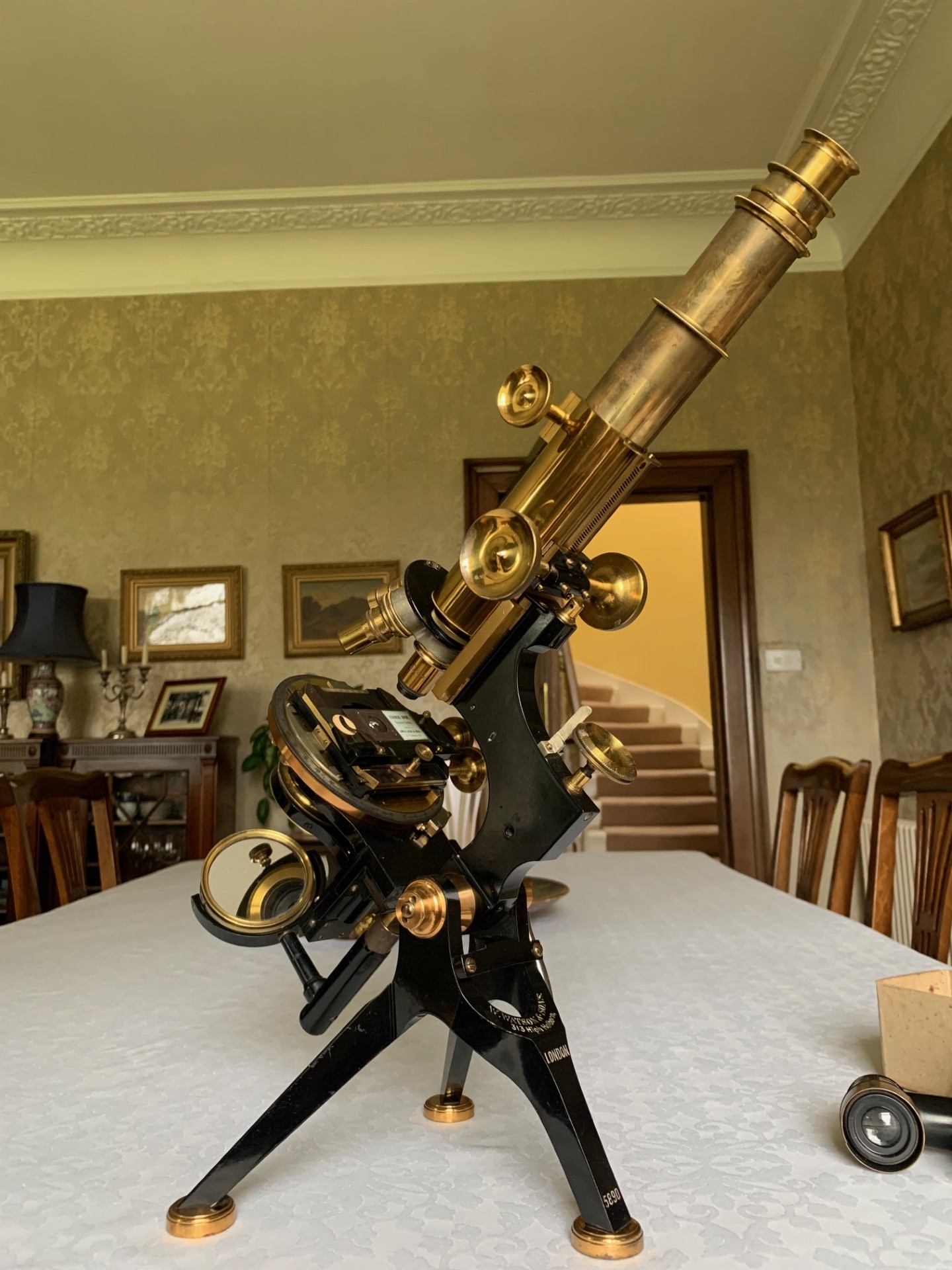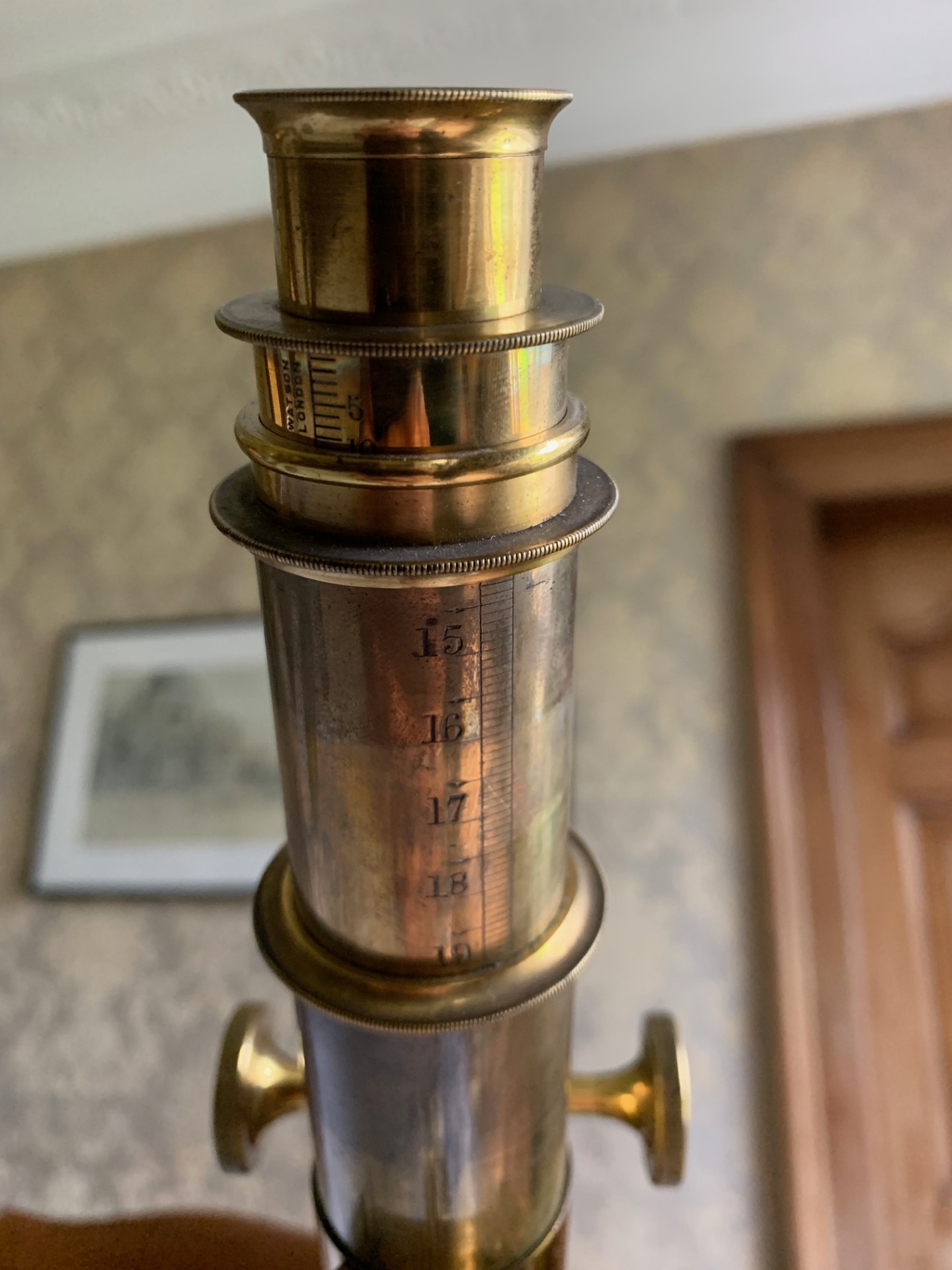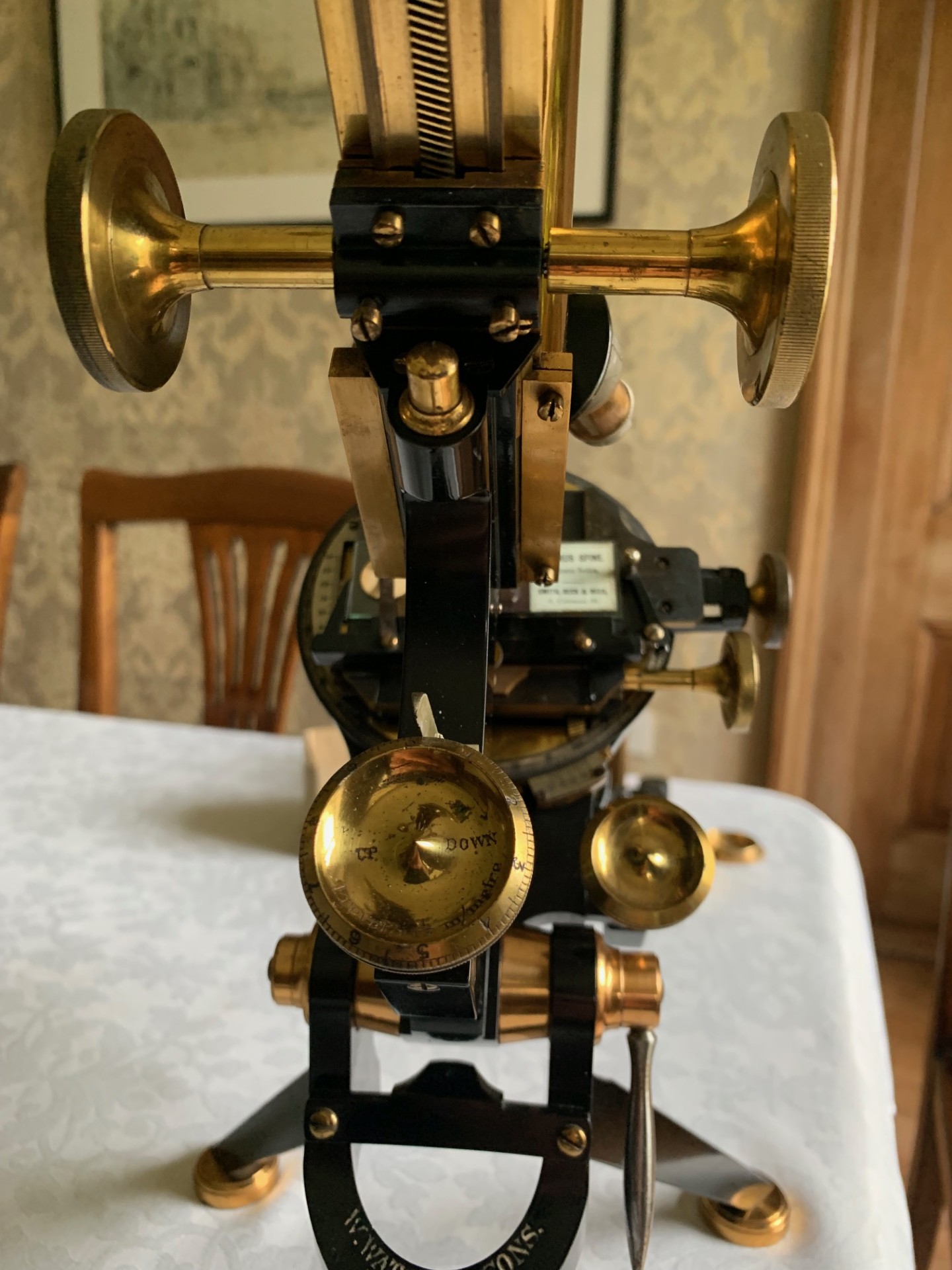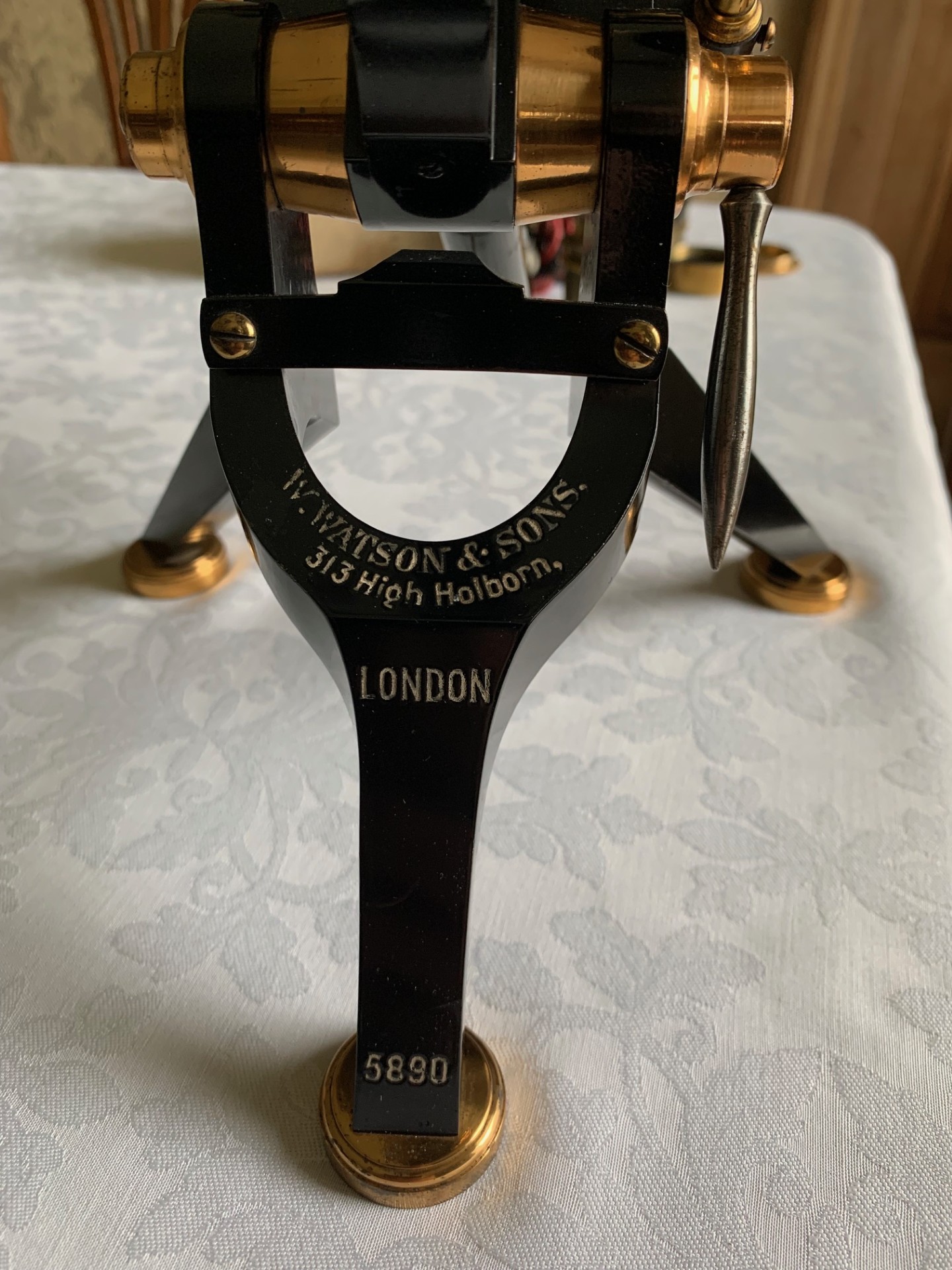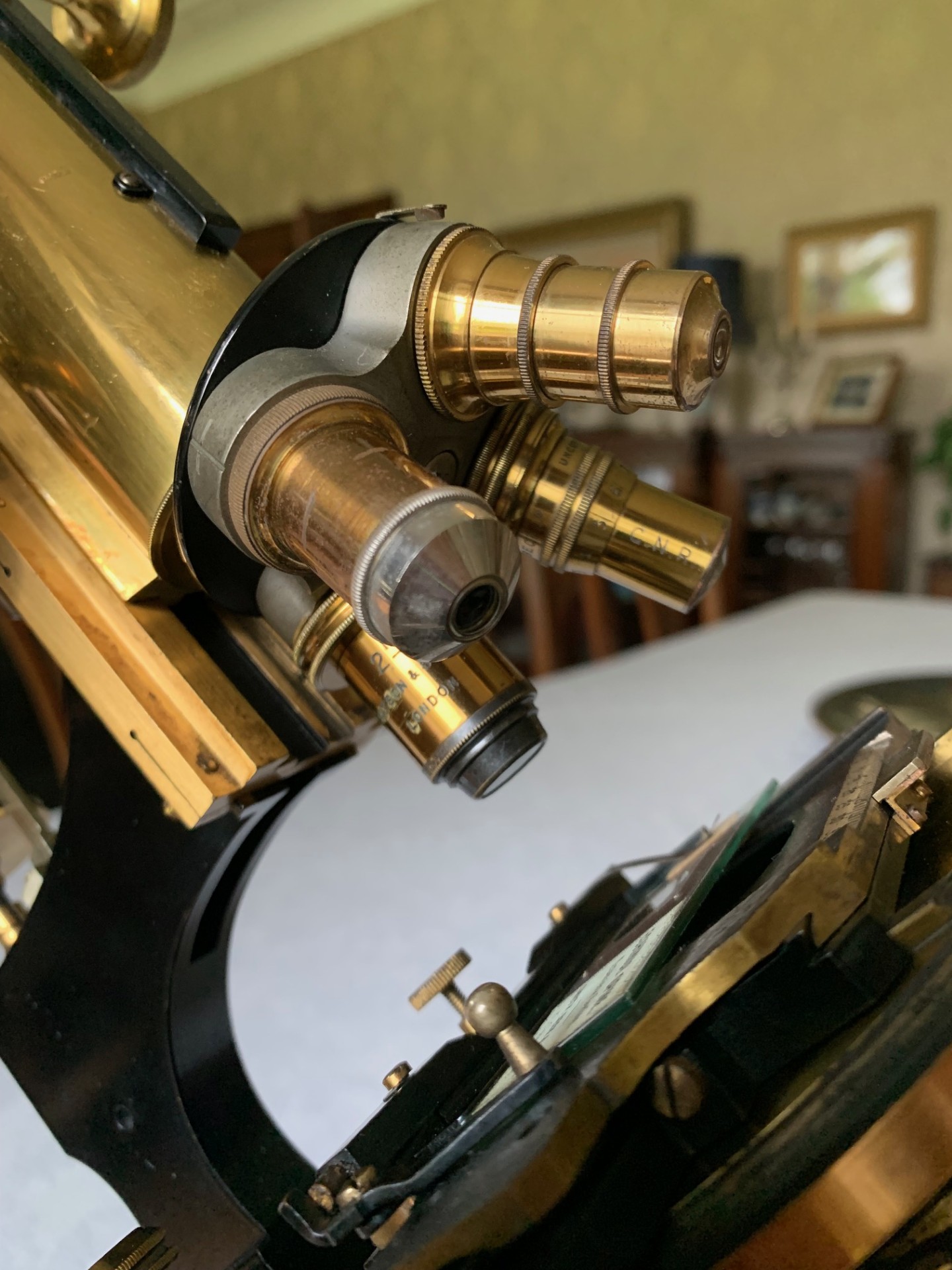Antique W. Watson & Sons Circuit Stage Van Heurck Brass Microscope – circa 1900
£2,495
Exceptionally good cosmetic condition example of Watson's rare Van Heurck stand with the even rarer full rotating circuit stage feature and near-perfect lacquer-work.
Circa
1900
Maker
W. Watson & Sons
Country of manufacture
UK and Ireland
Description
Offered for sale is a highly collectable example of Watson’s Van Heurck brass microscope and particularly special in that it’s the rare Circuit Stage model. It’s quite an imposing instrument standing over 18 inches high when the draw-tubes and coarse focus are both racked out. This example dates to around 1900 based on its serial number 5890 which is engraved on the tripod just above the rear brass bun-foot and means that it’s quite an early Circuit Stage model.
The Van Heurck model range was produced by W. Watson & Sons Ltd based on a design scheme originally proposed by famous Belgian microscopist Henri Van Heurck (1839 – 1909), hence the designation afforded to this top-of-the range series of Watson instruments. The Van Heurck, Royal and Edinburgh models of Watson microscope all bear the same signature shape and indeed the Van Heurck was essentially based upon Watson’s Edinburgh design of microscopes, which they had been manufacturing in various guises since about 1887. The signature form includes a tripod base and Lister-type upper limb with vernier screw/lever fine focus mechanism. The Van Heurck models tend to have additional features over and above both Royal and Edinburgh models and also sometimes various bespoke options or accessories, because Watson offered customisation and quite a number of discerning customers must have had their instruments built to their own individual specifications. Van Heurck’s aims with specifying this model’s key features appears to have been to assist with his study of diatoms, especially with improvements such as sub-stage fine adjustment and fully mechanical rotating stages. There were a number of different Van Heurck models produced by Watson with quite a complicated series of enhancements and developments, together with a range of accessories. The Van Heurck variants produced by Watson from around 1893, with final examples produced into the 1930s, were as follows:
1893 to 1896 – Van Heurck Model A
1893 to 1900 – Van Heurck Model B – double draw-tube added
1896 to 1921* – Van Heurck Grand Model – concentric x/y controls and slightly larger tripod giving enhanced overall size
1900 to 1923* – Van Heurck No. 1 – similar to Model B
1900 to 1923* – Van Heurck Circuit Stage – full 360 degree stage rotation – this example
* final versions – production would have continued beyond these dates into the 1930s
This example #5890 dating to about 1900 therefore appears to be a Circuit Stage with slightly elongated upper limb and sufficient room for the stage to complete a full 360 degree rotation without the x/y adjustment thumb-wheels catching on the sub-stage fine adjustment thumb-wheel – as demonstrated in the listing photos. I’m sure that the Watson cognoscenti will have their own views, but I believe that this example must be a Circuit Stage in view of the full rotation feature. The spread of the front tripod legs measures 8 inches and they are also shod with cork, both features of the Van Heurck model. I’ve also included an image of a Circuit Stage Van Heurck at the end of the listing photo stream sourced from Watson’s 1912 product catalogue. The image is of a later version with a few small technical differences, but useful for comparison nonetheless.
Turning to the technical details of this instrument, the coarse focus is via rack and pinion with smooth action and tension adjustment available for the pinion gear – slight slippage of left-hand thumb-wheel observed on occasion. Fine focus is achieved via a separate brass thumb-wheel with graduation markings up/down rubric with indicator confirming that one full revolution of the fine adjustment thumb-wheel = 1/13th mm of travel (for the optical tube). It’s located at the rear of the upper limb and works by a vernier screw acting on an internal lever system. The focusing technique being to achieve near focus with the coarse thumb-wheels, then fine-tune with the single rear thumb-wheel.
With its optics, this Watson Van Heurck comes fitted with a period graduated brass eyepiece draw-tube inside another brass graduated draw-tube operated via a rack and pinion system all of which sits inside the main brass optical tube. Extending the draw-tubes increases the available magnification quite noticeably and you also have to re-focus. There’s a two Watson top-hat eyepieces supplied with the instrument as under:
– 6x magnification with integral graduated draw-tube
– 10x magnification with integral graduated draw-tube
There are also five good quality brass objective lenses and an older-style quadruple turret which rotates freely with a nice positive feel as the objectives slot into their viewing positions:
– 2 inch para by Watson – 3x magnification
– No. 3 by Leitz Wetzlar – 10x magnification
– 1/6th inch by Watson – 40x magnification
– 1/8th inch by R & J Beck – 60x magnification with adjustment collar
– 1/12th inch Versalic by Watson – 100x magnification and requires oil immersion
Overall therefore, the range of magnification available with this Watson with the draw-tubes set at standard length ranges from about 18x with the lowest power lens combination, up to around 1,000x with the highest power combination and with the benefit of good illumination and of course oil immersion when using the Versalic 1/12th inch objective.
The fully mechanical circular stage is a delight to behold and use. It’s got twin thumb-wheel x/y adjusters on the right hand side of the stage with smooth positive action, silvered vernier scales for both axes and a silvered 360 degree scale around the outer edge. It is currently fitted with a sliding specimen holder for holding slides steady during inclined viewing and when the axes are being moved around which works very well and can be removed for cleaning or locked in position when in use. It’s also got a sprung slide holder arm on the right-hand side and at the left hand side there’s a lever for ejecting the slide, which is quite a neat feature that’s often over-looked. This being the Circuit Stage model, the stage also rotates and will complete a full 360 degree rotation – the action is well damped and holds position well on adjustment. The instrument also tilts for inclined viewing, holding in position as it should and can be tensioned as required via lever on the right-hand side of the pivot.
Turning to the sub-stage, we have a Watson condenser with swing-out capability top-mounted into a brass ring-carrier with centering controls comprising brass thumb-screws, which in turn sits in a height adjustable rack and pinion mount with additional vernier fine adjustment via a vertically mounted thumb-wheel located above and to the rear of the stage. There’s a single-sided brass thumb-wheel for coarse adjustment of the condenser height, which also has adequate reach for oiling to the back of slides as required. The condenser assembly also has a working iris to control lighting levels and there’s a 35mm swing-out carrier fitted for adding coloured, opaque of dark-field filters. Lighting is via a brass mounted plano-concave mirror on a height and swing adjustable brass support arm and gimbal, with period silvering that’s in very good period condition to both sides.
The instrument and its controls have been very gently cleaned, lightly lubricated where necessary with non-hardening grease and operate smoothly with age-appropriate signs of wear to moving parts and friction surfaces. This instrument presents amazingly well with lovely gleaming brass-work showing very few signs of tarnishing or spotting, which is what you’d hope to see on an instrument of this age and quality that’s been very well looked after and probably treasured as an heir-loom throughout its life. Overall, it’s in pretty good to excellent shape for its age and I’m in two minds whether to retain this example for my own collection – I guess time will tell. This Circuit Stage Van Heurck is essentially a very nice collectible Watson in the right condition and it’ll make a great usable instrument and also a stunning display piece. It also presents rather well while being used as a desk-top instrument and will also look good in a library or home office setting, especially when set up with an antique slide.
Accessories supplied with the instrument:
– set of 35mm dark-field stops in brass case
– 35mm blue filter
– nicol prism polariser and analyser for polarised light work
– sub-stage plug-in electric illuminator – will also need a 6V power supply unit – it’s untested and a PSU is not supplied with this listing
There’s currently no storage case with this example and I will endeavour to source an appropriate example in the near future and add to the listing if/when I can. The instrument stands around 13 inches high racked down, so it may be quite difficult to obtain a suitable case that’s large enough to accommodate this Van Heurck, particularly with the wide spread of the tripod legs.
Owing to the weight and delicacy of this antique microscope, it will be partially dismantled, very well wrapped for shipping and dispatched by insured courier upon receipt of cleared funds. Yes, it’s expensive, but it will be quite difficult to find another such example especially of the rare Circuit Stage variant in period condition that’s as good and if there’s a gap in your collection for a Van Heurck, or if a Van Heurck is something of a grail piece, as it was with me for a long time, then maybe you’ve finally found one.
Thanks for looking – please also check out my other listings if you get the chance.
Ask the Dealer
Dealer information
 Arcboutant Scientific
Arcboutant Scientific
Howard Nutton based in Glasgow Scotland with a background in Natural Science along with previous career in risk management. I obtained my first antique microscope in 1988 - it was a Watson Edinburgh model H serial number 23604 - dating it to 1918. Since that time I've owned and restored hundreds of similar instruments. As Arcboutant Scientific now also making available personally curated fine examples, principally of antique microscopes and associated scientific equipment by quality English and Continental makers, to collectors world-wide.




